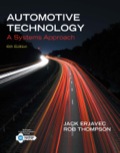
Concept explainers
Name the three major assemblies that make up a disc brake.
The three major assemblies used to make up a disc brake.
Answer to Problem 1RQ
The three major assemblies are hub and rotor assembly, a caliper assembly, and the brake pads assembly.
Explanation of Solution
The disc brakes are comprised of three assemblies which are hub and rotor assembly, a caliper assembly, and brake pads assembly. The hub and rotor assembly is divided into two parts i.e. hub and rotor in which hub is the part in which wheel is fitted and may carry wheel bearings also. The rotor is the part which is generally made up with cast iron and is machined in a way that it provides a friction surface for the brake pads.
The caliper assembly is the one which is fitted to convert the hydraulic pressure to the mechanical force and inspects for the lining wear by the hole which is present on top of it. Further, a caliper has a capacity of containing up to six cylinders and pistons that helps in providing same level of pressure distribution.
The brake pad assembly is made up of metal having linings which are either riveted or bonded to them. It helps in straddling the rotor due to its position on each side of calipers. The linings on pads are semi-metallic in nature.
Conclusion:
Thus, the three assemblies which are used in making disc brakes are hub and rotor assembly, a caliper assembly, and the brake pads assembly.
Want to see more full solutions like this?
Chapter 52 Solutions
EBK AUTOMOTIVE TECHNOLOGY: A SYSTEMS AP
 Introduction to Chemical Engineering Thermodynami...Chemical EngineeringISBN:9781259696527Author:J.M. Smith Termodinamica en ingenieria quimica, Hendrick C Van Ness, Michael Abbott, Mark SwihartPublisher:McGraw-Hill Education
Introduction to Chemical Engineering Thermodynami...Chemical EngineeringISBN:9781259696527Author:J.M. Smith Termodinamica en ingenieria quimica, Hendrick C Van Ness, Michael Abbott, Mark SwihartPublisher:McGraw-Hill Education Elementary Principles of Chemical Processes, Bind...Chemical EngineeringISBN:9781118431221Author:Richard M. Felder, Ronald W. Rousseau, Lisa G. BullardPublisher:WILEY
Elementary Principles of Chemical Processes, Bind...Chemical EngineeringISBN:9781118431221Author:Richard M. Felder, Ronald W. Rousseau, Lisa G. BullardPublisher:WILEY Elements of Chemical Reaction Engineering (5th Ed...Chemical EngineeringISBN:9780133887518Author:H. Scott FoglerPublisher:Prentice Hall
Elements of Chemical Reaction Engineering (5th Ed...Chemical EngineeringISBN:9780133887518Author:H. Scott FoglerPublisher:Prentice Hall
 Industrial Plastics: Theory and ApplicationsChemical EngineeringISBN:9781285061238Author:Lokensgard, ErikPublisher:Delmar Cengage Learning
Industrial Plastics: Theory and ApplicationsChemical EngineeringISBN:9781285061238Author:Lokensgard, ErikPublisher:Delmar Cengage Learning Unit Operations of Chemical EngineeringChemical EngineeringISBN:9780072848236Author:Warren McCabe, Julian C. Smith, Peter HarriottPublisher:McGraw-Hill Companies, The
Unit Operations of Chemical EngineeringChemical EngineeringISBN:9780072848236Author:Warren McCabe, Julian C. Smith, Peter HarriottPublisher:McGraw-Hill Companies, The





